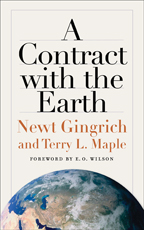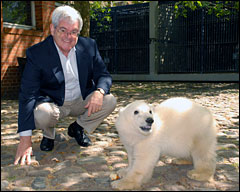
Newt and Knut. (Photo by Callista Gingrich, Gingrich Productions.)
Newt Gingrich says he feels a special kinship with a young polar bear named Knut, who was rescued from death last year by officials at the Berlin Zoo. Gingrich has visited Knut, and he’s been talking about the bear as he promotes his new book, A Contract With the Earth.
But is Gingrich’s cuddly new environmental image fitting? Environmentalists who remember the former speaker of the House primarily for his “Contract With America” may find a more appropriate animal mascot in Taricha granulosa, also known as the rough-skinned newt — one of the most poisonous creatures known to humankind. Just one of these newts, less than eight inches long, contains enough toxin to kill 12 members of the Sierra Club’s board of directors.
Contract Lens

Gingrich’s latest environmental pronouncements are packaged to look serious and sincere. A Contract With the Earth is published not by a mass-market publishing house, but by Johns Hopkins University Press. Gingrich, a former history professor, cowrote it with animal behaviorist and former Atlanta zoo director Terry Maple. The foreword was written by renowned biologist E. O. Wilson, a Harvard emeritus professor known for his eloquent advocacy of biodiversity conservation.
But the illusion of gravitas dissipates as soon as you start reading. Early in the book, Gingrich and Maple outline a 10-point “Contract With the Earth,” consisting mainly of nebulous platitudes, such as that America should “take the lead” with respect to environmental issues and “become an aspirational and inspirational nation.” We should also “reward a new generation of environmental entrepreneurs,” “retire or rejuvenate old technologies,” and “transform the role of government,” among other generalities. Each provision of the contract collapses under the burden of its own vacuousness.
If you are hoping for some clarification or additional perspective from Wilson’s foreword, you will be disappointed. He has kind words for the book and its authors, but his amorphous endorsement is only four paragraphs long, amounting to little more than an extended blurb written on the pages of the book instead of its jacket.
After the nonarticulation of the noncontract in the first few chapters, the authors use the remainder of the book to skate superficially over a multitude of examples of environmental activities they find praiseworthy. As with the broader principles, most of the case studies are hard to argue with — at least on the surface. For example, the authors commend efforts of the Case Foundation to install water pumps in African villages, bringing clean water to millions of people at low cost. Who could object to that? But summarized briefly as win-win solutions for everyone involved, the examples offer no broadly applicable insights. Even win-win solutions typically must overcome challenges in conception, design, and implementation before they succeed. And most real-world environmental problems require reconciling or balancing legitimate interests of conflicting parties.
In some cases, the authors present what appear to be examples of win-win solutions, but are actually examples of selective reporting. They extol a plan under which ships entering Boston Harbor are to be rerouted, at negligible cost, to lessen harm to right whales. Nobody is likely to argue that this is a bad policy. But the authors ignore the fact that the Boston decision is just one component of an ongoing, complex conflict about more severe restrictions on shipping activities that are probably needed along much of the East Coast to prevent right whale extinction. After celebrating the limited, local benefit of slightly altered shipping routes in one harbor, the authors quickly drop the right whale conservation issue entirely.
In the two pages following the whale story, the authors whiz through mentions of California condors, municipal recycling programs, and smoking on airplanes — before beginning the next chapter with a Winston Churchill quotation. This hyperactive approach — enthusiastically bringing up issues or examples, only to drop them quickly — is typical of the book as a whole.
How Green Is Gingrich?
In A Contract With the Earth, as well as in recent public statements he’s made about the environment, Gingrich doesn’t appear to say anything factually inaccurate, but he talks himself up as a longstanding supporter of environmental protection. In reality, Gingrich’s environmental record can be considered progressive only when compared with full-blooded environmental troglodytes like Dick Cheney or Rep. Don Young (R-Alaska).
MORE ON NEWT
Joseph Romm critiques Newt Gingrich’s record and techno-optimism.
Between 1979 and 1994, Gingrich’s House voting record earned him an average annual score of 29 percent from the nonpartisan League of Conservation Voters. That means he voted pro-environment on key issues 29 percent of the time, compared to a House average of more than 50 percent. (And even this 29 percent average masks a sharp decline in his scores over that period.)
Gingrich’s influence grew enormously when he assumed the speakership in 1995, after Republicans took control of Congress. The text of the “Contract With America,” the framing document for the Gingrich revolution, did not mention the environment, but it did contain opaque, euphemistic terms such as “unfunded mandate reform” and “risk assessment/cost-benefit analysis,” which the Gingrich-led majority used to justify a series of Republican bills that took clear aim at cornerstone environmental laws. The LCV summarized congressional action in 1995 as “an environmental train wreck.”
These attacks on environmental safeguards provoked public backlash. Gingrich, who has always been a skilled self-promoter, responded with an effort to reinvent himself as an environmentalist, which peaked around Earth Day 1996. He conceded publicly that the GOP had “mishandled” the environment issue. He formed an Environmental Task Force and advocated for a “new environmentalism” in a widely publicized speech before the National Environmental Policy Institute. He appeared with animals on The Tonight Show and Larry King Live, and missed no opportunity to remind people that he nearly became a zoo director instead of entering politics.
In 1996, Gingrich did manage to corral the rabid anti-green members of his Republican congressional menagerie, preventing them from tearing the Endangered Species Act limb from limb. He also demonstrated sporadic support for clean-air and clean-water legislation. But these efforts were noticeable mostly because they were viewed against a background of very low expectations. In the end, most of his activities as a born-again green were just for show.
In the years after 1998, when Gingrich resigned from Congress following midterm elections in which the Republicans fared worse than expected, he continued to display his characteristic energy and breadth of interests. But the environment was not a focus. He has worked as a commentator on Fox News and a senior fellow at the American Enterprise Institute, as well as a writer, speaker, and political consultant.
In his 2005 book Winning the Future, Gingrich outlines a broad policy vision for America, but devotes just one chapter to the environment and energy. In that section, he acknowledges that “global warming may happen,” but insists that we don’t understand what drives climatic change, and that we might actually be headed for another ice age. Scientists’ warnings about climate change, he writes, are “politically driven mass hysteria” about which “they have no scientific proof.”
A New Newt?
It is only in the last six months or so that Gingrich has sought to remake his environmental image again, as polls have shown the Bush administration’s anti-environmental policies to be increasingly out of step with public opinion. Gingrich hopes to score political points for himself and the GOP by talking about “green conservatism” and “entrepreneurial environmentalism,” though he’s never defined these new buzzwords with any specificity.
During an April 10, 2007, debate with John Kerry on environmental issues, Gingrich for the first time acknowledged the seriousness of climate change: “The evidence is sufficient that we should move towards the most effective possible steps to reduce carbon loading of the atmosphere … and [we should] do it urgently.” But he offered only a sketchy outline of what “the most effective possible steps” would be, and even less detail about what “moving towards them” would involve, or how fast “urgently” is.
If you squint hard at A Contract With the Earth and parse through Gingrich’s recent on-the-record comments, you can discern a few other elements of his new environmental vision. He believes in the awarding of cash prizes for green technological innovation. He favors tax credits for carbon-emission reduction and for the adoption of eco-friendly technologies (but he opposes carbon taxes and cap-and-trade schemes). And he would like to see investment in carbon-sequestration technology and new nuclear power plants. But Gingrich provides almost no detail on how he would implement these ideas, nor what makes him think they would they be sufficient to address the problem of climate change.
Eye on Newt
A person is always entitled to change his mind on an issue. But if Gingrich hopes to avoid the impression that his sudden change of heart is disingenuous and self-serving, he isn’t doing a very good job. Having failed to articulate a clear statement of the environmental policies he now favors, and having attempted to greenwash his environmental record, all that’s left of Gingrich’s supposed transformation is his promise to foster bipartisan collaboration on environmental issues.
Provision No. 8 of the “Contract With the Earth” demands that we “invoke the spirit of collaboration and cooperation.” Later in the book, the authors write, “It is time for each of us — whether our political views are left, right, or center — to stand up and demand an end to the squabbling … We are all members of a big-tent, bipartisan, multicultural ‘green team’ whose commitment to the environment is genuine.”
The problem is that Gingrich has made his reputation over the years by lobbing divisive, incendiary statements and accusations designed to grab headlines, and he hasn’t let up. It’s true that his bomb-throwing has been punctuated by periodic promises of reconciliation and bipartisanship — but these rarely outlast the newspaper headlines announcing them.
MORE ON WANGARI
Read an interview with Wangari Maathai and a review of her autobiography.
In A Contract With the Earth, one of the many environmentalists Gingrich and Maple briefly praise is Wangari Maathai of Kenya. She launched the successful Green Belt Movement in 1976, which so far has planted more than 20 million trees in Africa. Gingrich and Maple call her work “extraordinary … environmental heroism.” They note that she won the Nobel Peace Prize in 2004, and that this recognition “demonstrates how much forestation is valued throughout the world.”
But just a few weeks before these hopeful words landed on bookstore shelves, Al Gore won the same prize in recognition of his work on climate change. As the former speaker has so many times before, Gingrich forgot his recent promises of inclusiveness and collaboration. “It’s perfectly appropriate for Gore to win the Nobel Prize,” Gingrich said, “because it only goes to very left-wing people who are critical of America.”
If you’re still wondering whether Gingrich’s latest green transformation should be viewed with severe skepticism, perhaps a comment from Jay Leno can shed light on the question. In 1996, during one of Gingrich’s previous attempts to green his image, the then-speaker appeared on The Tonight Show with, among other species, a newt. As Gingrich was handling the amphibian, Leno said, “I hear they’re very slippery.”


